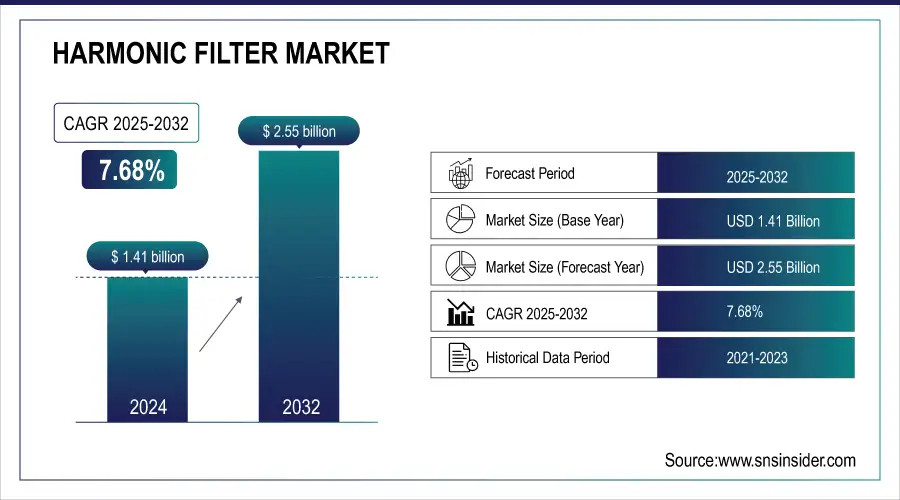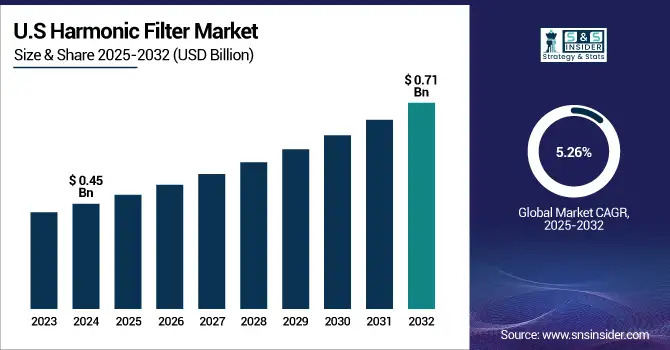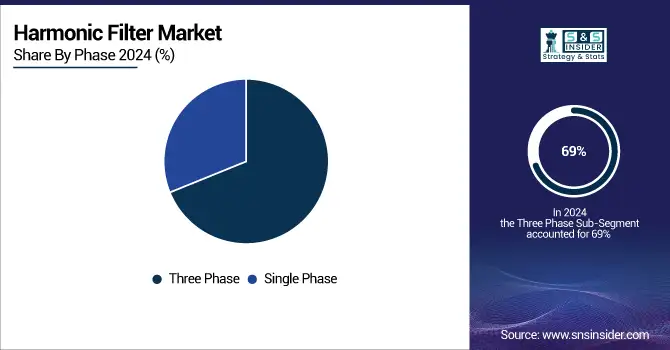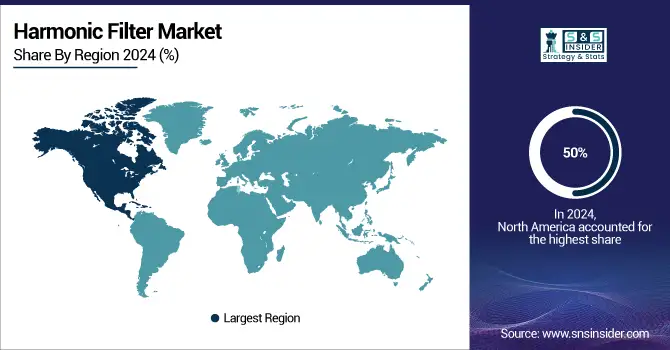Harmonic Filter Market Size & Trends:
The Harmonic Filter Market Size was valued at USD 1.41 billion in 2024 and is projected to reach USD 2.55 billion by 2032, growing at a CAGR of 7.68% from 2025 to 2032. Some of the major factors driving the market growth include the increasing demand for energy-efficient solutions across industries, rising regulatory pressure on power quality, and growing adoption of smart technologies. By minimizing the losses of energy and enhancing the reliability of the system, the harmonic filters play a key role for both industrial as well as commercial applications that help in improving energy efficiency.
Harmonic Filter Market Size and Forecast
-
Market Size in 2024: USD 1.41 Billion
-
Market Size by 2032: USD 2.55 Billion
-
CAGR: 7.68% from 2025 to 2032
-
Base Year: 2024
-
Forecast Period: 2025–2032
-
Historical Data: 2021–2023

To Get more information on Harmonic Filter Market - Request Free Sample Report
Key Harmonic Filter Market Trends
-
Growing adoption of energy-efficient and power quality solutions is driving demand for advanced harmonic filters across industrial and commercial sectors.
-
Integration of smart sensors and IoT-enabled monitoring is enhancing real-time detection and mitigation of electrical harmonics.
-
Increasing investments in renewable energy systems, such as solar and wind, are creating significant opportunities for harmonic filter deployment.
-
Rising industrial automation and digitization are fueling demand for reliable power conditioning solutions to protect sensitive equipment.
-
Stricter global regulations on electrical power quality and grid compliance are pushing industries to adopt efficient harmonic mitigation systems.
-
Development of modular and scalable harmonic filters is improving installation flexibility, maintenance efficiency, and operational reliability.
U.S. Harmonic Filter Market Insights
The U.S. market, valued at USD 0.45 billion in 2024, is projected to grow to USD 0.71 billion by 2032, with a CAGR of 5.26%. As energy efficiency initiatives continue to gain momentum, consumers increasingly prefer harmonic filters to ensure compliance with power quality standards, minimize operational costs, and support sustainability goals. These factors collectively contribute to the robust growth of the harmonic filter market, particularly in regions like the U.S.

Harmonic Filter Market Growth Drivers
-
Rising Power Quality Regulations Fueling Demand for Harmonic Filters in Compliance with Strict Standards
Governments and regulatory bodies worldwide are tightening power quality standards to ensure electrical systems function efficiently and safely, promoting the adoption of harmonic filters. These filters help mitigate harmonic distortions, which can damage equipment and cause operational disruptions. By adhering to strict regulations, industries can maintain power stability and prevent costly fines. As more sectors prioritize energy efficiency and grid stability, the demand for harmonic filters is expected to rise, especially in industries heavily reliant on sensitive equipment, such as manufacturing, telecommunications, and renewable energy sectors. This regulatory push ensures that businesses remain compliant while enhancing system performance and sustainability.
Harmonic Filter Market Restraints
-
The complexity of installation and maintenance of harmonic filters adds to their cost and time requirements, limiting widespread adoption.
Their installation requires skilled professionals for proper integration with electrical systems, and the filters also require periodic maintenance for optimal function. This complexity can prevent companies, particularly smaller ones, from implementing harmonic filters, due to the high costs relating to both installation and maintenance. Furthermore, the performance of these filters may deteriorate with time, which can ultimately affect the efficiency and power quality they are designed to improve if not properly maintained.
Harmonic Filter Market Opportunities
-
Rising Demand for Energy-Efficient Solutions in Industrial Applications Driving Harmonic Filter Adoption
As industries continue to seek ways to optimize energy consumption and reduce operational costs, the demand for energy-efficient solutions is rapidly increasing. Harmonic filters play a pivotal role in achieving these goals by improving the overall power quality in industrial environments. These filters help to mitigate harmonic distortion, which is common in industries that rely on non-linear loads, such as manufacturing facilities, chemical plants, and data centers. By reducing the energy losses caused by harmonic currents, harmonic filters enhance the efficiency of electrical systems, leading to lower energy consumption and cost savings. Additionally, they contribute to prolonging the lifespan of sensitive equipment by protecting it from voltage and current distortions. As industrial sectors strive to comply with energy regulations and sustainability goals, the adoption of harmonic filters is expected to rise significantly, positioning them as a key solution for improving energy efficiency in the market.
Harmonic Filter Market Challenges:
-
Integrating harmonic filters into older electrical systems presents a significant challenge due to the need for modifications or upgrades to existing infrastructure.
Many older systems were not originally designed to accommodate modern harmonic filters, which can lead to compatibility issues. Adding harmonic filters to these systems can call for substantial retrofitting or the installation of newer pieces of equipment. As a result, this could lead to longer installation times and costs, not to mention disruptions to normal operations. In addition, the capacity and flexibility of older systems may require additional engineering work to achieve the desired harmonic filter performance. This can create challenges for companies seeking to integrate these solutions into existing installations, as they may experience delays and increased costs in implementing harmonic filters in legacy systems, thereby limiting the penetration of these solutions in industries with aging infrastructure.
Harmonic Filter Market Segment Analysis:
By Phase
The three-phase segment dominated the harmonic filter market with approximately 69% of the revenue in 2024, driven by its widespread use in industrial and commercial applications. due to the mojority usage in the industrial and commercial applications. The three-phase system is widely used in sectors that demand energy-intensive operation, as harmonic distortions can result in expensive operational challenges. By reducing voltage and current distortions, harmonic filters within these systems minimise energy loss and improve the life cycle of equipment. The high friction of this segment can therefore be attributed to the prevailing usage of three-phase systems in sectors like manufacturing, large-scale operations, and commercial infrastructure. The continued expansion and modernization of these sectors will drive the requirement for harmonic filter to mitigate harmonics in three-phase systems, ensuring compliance to within the global standards and improving the performance of connected electrical devices.
The Single Phase segment is expected to be the fastest-growing in the harmonic filter market from 2025 to 2032. The growing acceptance of single-phase electrical systems among residential and small commercial sectors that are still notably affected by harmonic disruptions adversely affecting energy productivity and plant efficiency further provides a light to this growth. With the growing importance of eco-friendly solutions, particularly in minor instances, the number of harmonic filters in single-phase systems is prominent. Such filters minimize power losses, improve the quality of electrical supply, and increase the service life of electrical devices. Furthermore, the increasing integration of automation and smart home technologies, commonly powered by single-phase power systems, drives the need for harmonic filters.

By Product
In 2024, the passive segment of the harmonic filter market accounted for around 60% of the total revenue, making it the largest share holder. Passive harmonic filters are widely used for their simplicity, cost-effectiveness, and reliability in mitigating harmonic distortions in electrical systems. These filters typically consist of capacitors, inductors, and resistors and are designed to target specific frequencies. They are most commonly deployed in industrial settings, where they help ensure the smooth operation of machinery and equipment by minimizing power quality issues. Their ability to provide continuous and stable harmonic mitigation without requiring active control systems has contributed to their widespread adoption.
The active segment of the harmonic filter market is expected to witness the fastest growth from 2025 to 2032, driven by the increasing demand for more efficient and dynamic power quality solutions. Unlike passive filters, active harmonic filters can adapt to changing loads and varying harmonic distortions, offering real-time, precise control over power quality. This makes them highly desirable in industries and applications where maintaining optimal power conditions is crucial for equipment performance and energy efficiency. The rising need for sustainable energy management, coupled with stringent power quality regulations, is propelling the adoption of active filters. Moreover, as industries become more reliant on sensitive equipment and automation systems, the demand for active filters that offer superior harmonic mitigation and flexibility is expected to grow significantly during the forecast period.
By Voltage
The low voltage segment dominated the harmonic filter market in 2024, accounting for approximately 36% of the total revenue. The low voltage segment dominated the market due to the extensive adoption of low voltage systems in multiple verticals such as manufacturing, commercial, and residential. Their high dependence on electronic devices, variable frequency drives (VFD), and other power electronics in the low voltage systems leads to non-linear loads that cause harmonic distortions. In these applications, the negative influence of harmonics, such as overheating of equipment, lost system efficiency, and damage to electrical infrastructure are avoided by using harmonic filters. The segment is also projected to register high growth during the forecast period as awareness of power quality and energy efficiency increases, specifically within regions where there are power quality regulations.
The medium voltage segment in the harmonic filter market is expected to experience the fastest growth from 2025 to 2032. The primary growth factor for this market is the growing demand for low-cost power quality in industrial and commercial applications utilizing medium voltage systems. With the widespread adoption of modern machinery and automation systems in various industries, the amount of harmonics generated has increased; therefore, the use of harmonic filters has become necessary to protect sensitive equipment and enhance energy efficiency. The second tier is medium voltage systems ranging from 1kV to 36kV, and ensure larger scale operations such as manufacturing plants, data centers and utilities. As power quality standards become increasingly stringent and industries seek more energy-efficient solutions, the medium voltage harmonic filter market is set to grow substantially over the coming years. The same trend is also aided by the increasing emphasis on energy consumption reduction and improving the efficiency of electrical networks.
By End Use
The industrial segment dominated the harmonic filter market in 2024, contributing approximately 60% of the total revenue. This market dominance can be attributed to the rising demand for power quality solutions in industries such as manufacturing, energy, and heavy industries, where the need for uninterrupted and stable power is critical. Harmonic filters are essential in these sectors to mitigate power disturbances, improve the efficiency of electrical equipment, and comply with increasingly stringent power quality standards. The growing adoption of automated systems and advanced machinery in industrial settings further fuels the demand for harmonic filters, ensuring optimal performance and reducing energy wastage. As industrial operations continue to expand and modernize, the reliance on harmonic filters to maintain smooth and efficient electrical systems will remain a key driver of growth in this segment.
The commercial segment is expected to be the fastest-growing in the harmonic filter market from 2025 to 2032. This growth is driven by the increasing demand for reliable and efficient electrical systems in commercial buildings such as offices, retail spaces, and hotels. As commercial establishments continue to expand and incorporate advanced technologies, the need for harmonic filters to maintain power quality and prevent disruptions becomes crucial. Harmonic filters help to ensure that electrical equipment operates efficiently, reducing energy consumption and preventing potential damage caused by harmonic distortions. Additionally, the rising focus on energy efficiency and sustainability in commercial properties is further fueling the demand for harmonic filters. With stricter regulations and an increasing emphasis on reducing operational costs, commercial establishments are expected to invest more in these solutions over the forecast period.
Harmonic Filter Market Regional Analysis:
North America Harmonic Filter Market Insights
The North America segment of the harmonic filter market experienced significant growth, contributing to around 50% of the total revenue in 2024. The US and Canada protested and protested and protested and protested, protesting for democratic freedoms on their own soil. With more industries looking at energy-efficient solutions, the demand for harmonic filters has risen with the need to maintain power quality and decreasing operational costs. In North America, the increasing emphasis on renewable energy integration and stricter power quality regulations will further drive the harmonic filters market. Furthermore, presence of market key players and focus on sustainability is also propelling the growth of the market. With further innovation in infrastructure across various industries in North America, this region is foreseen to gain significant market share of harmonic filters.

Get Customized Report as per Your Business Requirement - Enquiry Now
Asia Pacific Harmonic Filter Market Insights
The Asia-Pacific region is expected to be the fastest-growing segment in the harmonic filter market during the forecast period from 2025 to 2032 This is largely due to ongoing industrialization, urbanization, and demand for energy-efficient solutions in major countries among them China, India, and Japan. The large-scale infrastructure development in the region, the expansion of manufacturing industries and stringent power quality standards are said to be the factors driving the growth of harmonic filters. Additionally, the growing emphasis on solar energy solutions reflects the growing investments in renewable energy sources alongside the deployment of energy-efficient technologies which will contribute toward the growth of market in Asia-Pacific. As businesses and governments in the region prioritize energy savings and sustainable practices, the adoption of harmonic filters is anticipated to see significant growth, especially in sectors such as manufacturing, construction, and commercial buildings. This makes the Asia-Pacific region a key market for harmonic filter solutions in the coming years.
Europe Harmonic Filter Market Insights
The Europe Harmonic Filter Market is poised for steady growth in 2024, driven by strict environmental regulations and the region’s focus on industrial emission control. Countries such as Germany, the U.K., and France are adopting advanced harmonic filter systems across manufacturing, refineries, and energy sectors. Increasing emphasis on energy efficiency, renewable integration, and government-backed sustainability initiatives encourages industries to deploy real-time monitoring and AI-based power quality solutions. Moreover, expanding industrial automation and digitalization trends are strengthening demand for reliable and scalable harmonic mitigation systems.
Latin America (LATAM) Harmonic Filter Market Insights
The LATAM Harmonic Filter Market is experiencing moderate growth in 2024, supported by expansion of industrial and energy infrastructure in Brazil, Mexico, and Argentina. Increasing awareness of power quality issues and tightening energy regulations are prompting industries to adopt automated harmonic filter solutions. Investments in sustainable energy projects, refinery modernization, and collaborations between regional energy authorities and technology providers are further boosting adoption of cost-effective and reliable monitoring systems across the region.
Middle East & Africa (MEA) Harmonic Filter Market Insights
The MEA Harmonic Filter Market is witnessing robust growth in 2024, fueled by large-scale industrial and energy operations in Saudi Arabia, UAE, and South Africa. Governments are actively implementing regulations to minimize power disturbances and improve energy efficiency, creating strong demand for harmonic filter solutions. Expansion of refinery capacities, digitalization initiatives, and integration of smart monitoring technologies are supporting technological adoption. Furthermore, strategic collaborations between energy companies and monitoring solution providers are enhancing compliance with global power quality standards and sustainability objectives.
Competitive Landscape for Harmonic Filter Market
ABB
ABB is a global leader in power and automation technologies, providing solutions that improve efficiency, reliability, and energy management across industrial and commercial sectors. The company focuses on power quality, harmonic mitigation, automation, and energy-efficient drive systems.
-
- In November 2024, ABB launched the ACS8080 medium voltage drives, which achieve efficiencies up to 98% and reduce harmonic distortion by 50% compared to traditional control methods. The drives integrate advanced diagnostics, enabling faster troubleshooting, extending equipment lifetimes, and delivering energy savings across industrial and manufacturing applications.
Harmonic Filter Companies are:
-
ABB
-
Siemens
-
Emerson Electric Co.
-
Danfoss A/S
-
Schaffner Holding AG
-
Eaton
-
Comsys AB
-
MTE Corporation
-
Baron Power
-
Mitsubishi Electric
-
General Electric
-
Rockwell Automation
-
Fuji Electric
-
Phoenix Contact
-
SEL (Schweitzer Engineering Laboratories)
-
Yaskawa Electric Corporation
-
Delta Electronics
-
Schneider Electric India
| Report Attributes | Details |
|---|---|
| Market Size in 2024 | USD 1.41 Billion |
| Market Size by 2032 | USD 2.55 Billion |
| CAGR | CAGR of 7.68% From 2025 to 2032 |
| Base Year | 2024 |
| Forecast Period | 2025-2032 |
| Historical Data | 2021-2023 |
| Report Scope & Coverage | Market Size, Segments Analysis, Competitive Landscape, Regional Analysis, DROC & SWOT Analysis, Forecast Outlook |
| Key Segments | • By Product (Active, Passive, Hybrid) • By Phase (Single Phase, Three Phase) • By Voltage (Low Voltage, Medium Voltage, High Voltage) • By End Use(Industrial, Commercial, Residential) |
| Regional Analysis/Coverage | North America (US, Canada), Europe (Germany, France, UK, Italy, Spain, Poland, Russsia, Rest of Europe), Asia Pacific (China, India, Japan, South Korea, Australia,ASEAN Countries, Rest of Asia Pacific), Middle East & Africa (UAE, Saudi Arabia, Qatar, South Africa, Rest of Middle East & Africa), Latin America (Brazil, Argentina, Mexico, Colombia Rest of Latin America) |
| Company Profiles | ABB, Schneider Electric, Siemens, Emerson Electric Co., Danfoss A/S, Schaffner Holding AG, TDK Corporation, Eaton, Comsys AB, MTE Corporation, Baron Power, Mitsubishi Electric, General Electric, Rockwell Automation, Fuji Electric, Phoenix Contact, SEL (Schweitzer Engineering Laboratories), Yaskawa Electric Corporation, Delta Electronics, Schneider Electric India |

